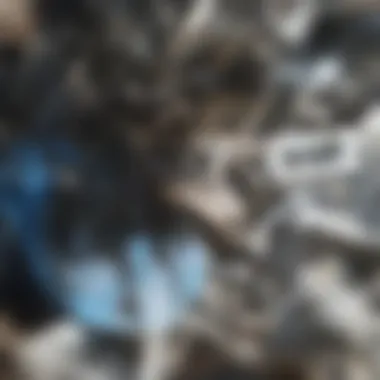Bilirubin Lights for Infants: An In-Depth Exploration


Intro
Bilirubin phototherapy plays a significant role in treating hyperbilirubinemia in infants. This condition, characterized by elevated levels of bilirubin in the bloodstream, is common in newborns. If left untreated, it can lead to serious health issues. The implementation of bilirubin lights has become a standard approach in neonatal care. Understanding how these light therapies work, their application, and the evolution of treatment can offer vital insights for students, researchers, and healthcare professionals alike.
In this exploration, we will delve into the physiological mechanisms behind hyperbilirubinemia, methodologies for bilirubin phototherapy, and a thorough discussion of current research and practices in the field. The information presented here not only aims to educate but also to provide a framework for future advancements in this essential area of neonatal care.
Methodologies
This section outlines the research techniques and tools refined by clinicians and researchers to assess the effectiveness of bilirubin light therapy.
Description of Research Techniques
Research regarding bilirubin phototherapy often involves clinical trials, observational studies, and retrospective data analysis. These methodologies help to determine the efficacy of various light sources and the overall impact of phototherapy on bilirubin levels in infants.
For example, randomized controlled trials are valuable for establishing a cause-effect relationship between phototherapy usage and reduced bilirubin levels. Similarly, cohort studies can provide insights into long-term outcomes associated with hyperbilirubinemia treatment.
Tools and Technologies Used
The technologies employed in bilirubin phototherapy are diverse. Commonly, LED lights are utilized for their efficiency and lower heat emission.
- Fiber-optic devices are also gaining traction due to their flexibility and ability to deliver light directly onto the skin.
- Incandescent lights, previously a standard, are less common today, given advancements in energy-efficient options.
The introduction of bilirubin meters provides real-time monitoring of bilirubin levels, aiding in effective treatment adjustments. This monitoring is crucial as it informs clinical decisions and enhances the effectiveness of therapy.
"Real-time bilirubin monitoring coupled with phototherapy can significantly improve treatment outcomes."
Discussion
Examining the current landscape of bilirubin phototherapy entails reflecting on previous research and its implications for clinical practice.
Comparison with Previous Research
Earlier studies primarily focused on the overall effectiveness of phototherapy in lowering bilirubin levels. Modern research expands this scope by considering various light wavelengths, treatment duration, and the influence of underlying health conditions of the infants. Comparisons between traditional methods and newer technologies reveal significant improvements in treatment efficiency and safety.
Theoretical Implications
The findings from recent research have substantial theoretical implications. Understanding the mechanisms of how light interacts with bilirubin encourages continued innovation in treatment protocols. This includes tailoring therapies that consider individual patient needs based on evolving evidence.
Understanding Neonatal Hyperbilirubinemia
Neonatal hyperbilirubinemia is a significant condition affecting many newborns, making it essential to grasp its implications for treatment strategies, specifically phototherapy. Bilirubin is a yellow substance produced during the breakdown of red blood cells. High levels can lead to neonatal jaundice, a condition visible typically as yellowing of the skin and eyes. Understanding hyperbilirubinemia provides insight into the underlying physiology and treatment approaches, which is crucial for healthcare providers and caregivers.
In many cases, hyperbilirubinemia is temporary and resolves without intervention. However, elevated bilirubin levels carry potential risks, including neurological damage if not addressed appropriately. Therefore, recognizing the signs and the underlying mechanisms is fundamental in guiding effective management strategies.
Physiology of Bilirubin Metabolism
Bilirubin metabolism involves several physiological processes. Initially, when red blood cells break down, they release hemoglobin, which is then converted into bilirubin. This unconjugated bilirubin is fat-soluble and non-polar, making it difficult for the body to excrete. To facilitate elimination, bilirubin must be conjugated in the liver, where it becomes water-soluble. Once conjugated, it enters the bile and is excreted via the intestines.
In newborns, especially preterm infants, this metabolic pathway is often immature. Thus, the clearance of bilirubin is less efficient, leading to accumulations.
Common Causes of Elevated Bilirubin Levels
Several factors contribute to increased bilirubin levels in neonates:
- Physiological Jaundice: Common in healthy newborns, usually resolving within the first two weeks after birth.
- Hemolytic Disease: Conditions such as Rh or ABO incompatibility can cause significant breakdown of red blood cells.
- Breastfeeding Jaundice: May occur due to inadequate breastfeeding or dehydration in the first few days, affecting bilirubin levels.
- Infections and Metabolic Disorders: Infections can lead to increased levels due to hemolysis, and genetic metabolic conditions can also interfere with bilirubin processing.
Understanding these causes is vital for healthcare providers when evaluating newborns with hyperbilirubinemia.
Risk Factors Associated with Neonatal Jaundice


Various risk factors can increase the likelihood of developing neonatal jaundice, including:
- Gestational Age: Premature infants are at higher risk due to their liver's immaturity.
- Blood Group Differences: Newborns with blood group incompatibility are more susceptible to hemolytic diseases.
- Family History: A familial tendency to elevated bilirubin levels can play a role in risk assessment.
- Nutritional Status: Inadequate feeding can exacerbate jaundice.
Addressing these risk factors is crucial in monitoring and managing affected infants, ensuring timely interventions when necessary.
The Role of Phototherapy in Treatment
The treatment of neonatal hyperbilirubinemia often relies on phototherapy, which is a key intervention in managing elevated bilirubin levels in infants. This section explores the various aspects of phototherapy and emphasizes its significant role in clinical practice.
Phototherapy works primarily by converting bilirubin into a more water-soluble form that can be more easily excreted by the newborn's immature liver. This conversion is crucial, as it helps to prevent the potential complications associated with high bilirubin levels, such as kernicterus, which can lead to serious neurological damage.
Mechanism of Action of Bilirubin Lights
Bilirubin lights operate based on the principle of photochemical reaction. When bilirubin is exposed to specific wavelengths of light, it undergoes a transformation that makes it easier for the body to eliminate. The predominant range of light used is in the blue spectrum, where wavelengths between 450 and 490 nm are most effective. This process, known as photodegradation, helps to decrease the total serum bilirubin levels significantly.
In clinical settings, healthcare providers monitor bilirubin levels closely, determining when to initiate phototherapy. The integration of these light therapies in treating hyperbilirubinemia has proven to be a practical, safe, and effective method to manage this condition in newborns.
Types of Phototherapy Devices
The choice of phototherapy device can impact treatment outcomes. Each type of device has distinct characteristics that influence its effectiveness and ease of use. Here, we explore the three major types of phototherapy devices alongside their respective contributions to treatment:
Conventional Phototherapy Units
Conventional phototherapy units are widely utilized in many hospitals. They consist of fluorescent light bulbs that emit blue light, effectively targeting bilirubin in the skin. One key characteristic of these units is their ability to cover a large area, ensuring that a substantial portion of the infant's body is exposed to the light.
The advantage of conventional units is their straightforward setup and high intensity. However, they can be less effective at light penetration compared to newer technologies, which can sometimes limit their overall efficacy in severe cases.
Fiber-Optic Devices
Fiber-optic devices represent an innovative approach to phototherapy. They use fiber-optic cables to deliver light directly to the infant’s skin. This method allows for a more focused treatment approach, often providing more effective bilirubin reduction.
A notable feature of fiber-optic devices is their capacity for portability, which enables treatment while allowing for positioning and handling of the infant. However, one drawback may be the need for close monitoring to ensure effective exposure.
Light-Emitting Diodes
Light-emitting diodes (LEDs) have emerged as a newer option in phototherapy. These devices offer the advantage of higher efficiency and lower heat production compared to traditional fluorescent lights. Their compact design allows for flexibility in their application and use in varying clinical settings.
LEDs are popular due to their consistent intensity and broad spectrum of light provided. However, they may require more frequent calibration and can be more costly than conventional units.
Indications for Phototherapy Initiation
Beginning phototherapy treatment depends on specific clinical indications. Healthcare professionals assess bilirubin levels, gestational age, and the overall health of the infant to decide when intervention is necessary. Criteria such as the infant's weight and any underlying medical conditions also play a crucial role in this determination.
Effective phototherapy can significantly decline total bilirubin levels, improving the infant’s condition and reducing the risk of potential consequences from hyperbilirubinemia. Regular monitoring and timely initiation of treatment are integral components in achieving desired clinical outcomes.
Clinical Guidelines for Phototherapy
Understanding clinical guidelines for phototherapy is crucial for ensuring optimal outcomes for infants undergoing treatment for hyperbilirubinemia. These guidelines provide a framework that clinicians can follow to make informed decisions regarding the initiation, duration, intensity, and discontinuation of phototherapy. By adhering to these protocols, healthcare providers can enhance patient safety, minimize potential complications, and improve overall efficiency in treatment.
Criteria for Treatment Initiation
The criteria for initiating phototherapy are primarily based on the blood bilirubin levels, the age of the infant in hours, and the risk factors present. Generally, treatment should be considered if the total serum bilirubin level exceeds established thresholds, which can vary depending on the infant's age in hours and clinical conditions.
Important criteria include:
- Gestational age: Premature infants have different bilirubin thresholds for treatment compared to term infants.
- Total bilirubin levels: Providers must refer to specific bilirubin levels that dictate treatment.
- Risk factors: Infants with conditions such as hemolytic disease or significant medical complications may require earlier intervention.
Early detection remains key in managing jaundice effectively. Continuous monitoring is advised, including a reevaluation of bilirubin levels and overall clinical status.


Duration and Intensity of Treatment
Duration and intensity of phototherapy are critical factors affecting the efficacy of treatment. The recommended duration often depends on the bilirubin response to therapy. A balance must be achieved whereby treatment is administered long enough to effectively lower bilirubin levels, while also minimizing prolonged exposure to light.
Considerations include:
- Type of phototherapy device: Devices such as conventional phototherapy units, fiber-optic devices, and light-emitting diodes may have different recommendations based on their efficacy.
- Bilirubin level decrease: If bilirubin levels decrease satisfactorily, a reduction in intensity or frequency of treatment can be considered.
- Monitoring: Clinicians should conduct regular assessments to ensure efficacy and adjust treatment duration accordingly.
Discontinuation Criteria
Discontinuation of phototherapy is a critical decision point in managing bilirubin levels. Various factors come into play when deciding to cease treatment.
Criteria for discontinuation typically include:
- Normalization of bilirubin levels: Once the total bilirubin levels fall below the threshold, discontinuation can be considered.
- Clinical stability: The infant should be observed for stability in the absence of active treatment.
- Follow-up care: Appropriate follow-up is necessary to monitor bilirubin levels post-discontinuation and ensure no rebound increases occur.
It is essential to document the decision-making process clearly, as this provides insight into treatment effectiveness and patient outcomes.
Proper application of clinical guidelines can significantly impact infant health and recovery. Regular training and review of protocols should be encouraged among healthcare professionals.
Monitoring and Assessment During Treatment
Monitoring and assessment during treatment is a crucial aspect of managing neonatal hyperbilirubinemia with bilirubin lights. Effective monitoring not only ensures the efficacy of the phototherapy but also safeguards the health of the infant. Continuous evaluation involves tracking the bilirubin levels, visually assessing jaundice, and adhering to safety protocols. These components are essential for determining the appropriate intervention needed to improve patient outcomes.
Blood Bilirubin Level Monitoring
Blood bilirubin level monitoring is fundamental in assessing the severity of jaundice in infants. This method typically involves measuring the total bilirubin concentration in the blood. Frequent tests are important as they provide immediate feedback regarding the infant's condition and treatment response.
Key considerations in blood bilirubin monitoring include:
- Timing of Tests: Blood tests should be scheduled regularly to monitor changes in bilirubin levels, especially in the first week after birth, when levels can rise rapidly.
- Use of Transcutaneous Bilirubinometers: These devices have become widely utilized as they allow for non-invasive assessment of bilirubin levels. They provide a preliminary estimate and can help determine if blood tests are necessary.
- Assessment of Trends: Observing the trend in bilirubin levels is essential. Stabilization or decline indicates a positive response to treatment, while a rise may necessitate adjustments in therapy.
Visual Assessment of Jaundice
Visual assessment of jaundice is another critical element in monitoring infants undergoing phototherapy. This involves physically examining the infant for signs of jaundice, which typically presents as a yellowish tint to the skin and sclera.
Important factors in this assessment are:
- Skill Level of the Assessor: Trained healthcare professionals, who are knowledgeable about typical jaundice appearance, should conduct the assessment to ensure accuracy.
- Lighting and Techniques: Proper lighting conditions enhance visibility, allowing for a more accurate assessment. The best time for visual checks is when the infant is in natural light, if possible.
- Documenting Observations: It is vital to document any visual assessment findings systematically. This aids in detecting patterns and plays a role in future evaluations, contributing to informed treatment decisions.
Patient Safety Protocols
Patient safety protocols are imperative to minimize potential risks during phototherapy. Establishing safety measures helps address concerns that may arise when infants are treated with bilirubin lights.
Key safety protocols include:
- Skin and Eye Protection: Infants should have their eyes covered with protective patches or goggles to prevent damage from bright lights, and skin should be safeguarded against excessive exposure.
- Monitoring Environmental Conditions: The ambient temperature should be controlled to avoid overheating, which can lead to dehydration and other complications.
- Regular Assessments of Vital Signs: Continuous checks of the infant's vital signs, including heart rate and temperature, are critical to ensure stable health status during treatment.
By implementing these monitoring techniques and safety protocols, healthcare providers help ensure that infants receive effective treatment for hyperbilirubinemia while minimizing potential risks. This integrated approach underscores the importance of careful observation and intervention in neonatal care.
Potential Risks and Complications
Understanding the potential risks and complications associated with bilirubin phototherapy is essential in neonatal care. Awareness of these elements enables healthcare providers to balance the benefits of treatment against any possible adverse effects. It's vital for professionals to remain vigilant while applying phototherapy to ensure optimum outcomes for infants.
Common Side Effects of Phototherapy
Phototherapy, while generally considered safe, can lead to several common side effects. These side effects may include:
- Skin rash: Some infants may develop a localized rash where light is applied.
- Temperature instability: Exposure to the lights can affect a baby’s ability to regulate body temperature, necessitating close monitoring.
- Dehydration: Phototherapy can lead to increased fluid loss through the skin. Therefore, hydration levels should be frequently checked.
- Eye damage: Direct exposure to bright lights can harm infants’ sensitive eyes. Infants must wear eye protection during treatment to avoid complications.


These side effects are mostly mild and manageable with proper care. Nonetheless, continuous observation is vital to prevent complications from escalating and to ensure the effectiveness of the treatment.
Long-Term Outcomes Associated with Phototherapy
The long-term effects of phototherapy are of significant concern. Most studies indicate that when used appropriately, phototherapy does not impose major adverse long-term outcomes. However, some infants may experience:
- Changes in skin pigmentation: Post-treatment, some infants could notice variations in skin tone. This effect is often temporary.
- Bilirubin-induced neurological dysfunction: There are rare instances where phototherapy does not effectively lower bilirubin levels, leading to serious conditions such as kernicterus. Regular monitoring helps mitigate this risk.
- Parental anxiety: Parents may express concerns about the potential for long-term effects, which could influence family dynamics and bonding.
Given these possible outcomes, ongoing research and clinical awareness are crucial for effectively addressing and managing any long-term implications for infants undergoing phototherapy.
Addressing Parental Concerns and Education
Parental concerns surrounding phototherapy must be taken seriously. It is important to engage parents in discussions about the treatment to foster understanding and alleviate fears. Key strategies include:
- Providing clear information: Parents should be educated on the purpose, process, and expected outcomes of phototherapy. Knowledge empowers caregivers to participate actively in their baby's health journey.
- Discussing potential side effects: Transparency about possible side effects can help parents prepare and understand the treatment's context.
- Encouraging open dialogue: Allowing parents to ask questions builds trust and supports collaborative care.
- Following up post-treatment: Regular check-ins after phototherapy are essential for addressing lingering concerns and monitoring the child’s health status.
Educating parents as key stakeholders in treatment fosters a positive environment for both the healthcare team and the family, ultimately enhancing patient outcomes.
"Education is key to empowerment, allowing families to feel confident in the care of their newborns."
Advancements in Phototherapy Research
The exploration of advancements in phototherapy research is integral to the understanding and treatment of neonatal hyperbilirubinemia. This field has witnessed significant evolution, leading to improved outcomes for infants affected by elevated bilirubin levels. Innovations not only enhance the effectiveness of phototherapy but also address safety and comfort during treatment. The focus on research is not just academic; it provides practical implications for clinical practice that can directly benefit patient care.
Emerging Technologies in Light Therapy
Emerging technologies in light therapy have expanded the toolkit available for treating neonatal jaundice. The transition from traditional phototherapy units to modernized devices has been crucial. Current innovations include:
- LED devices: These units use light-emitting diodes that are more energy-efficient and lighter than prior options. Their versatility allows for portable use, making treatment more accessible.
- Hybrid phototherapy systems: Combining different light sources helps to optimize the phototherapy effect. For instance, systems that merge blue and green light cater to a broader spectrum of bilirubin absorption.
- Wearable phototherapy: This includes fiber-optic blankets and vests that enable infants to receive treatment while still being able to interact with their parents.
These technologies enhance the ability to deliver consistent light exposure while minimizing the potential for dermatological complications. The ongoing development of these devices demonstrates a commitment to advancing the standards of care.
Current Studies on Effectiveness
Studies examining the effectiveness of various phototherapy modalities are essential for evidence-based practices. Current research indicates that specific parameters, like wavelength and intensity of light, significantly influence treatment outcomes. Recent findings suggest:
- Treatments using LED light can reduce bilirubin levels more efficiently compared to fluorescent systems.
- The combination of phototherapy with other treatments, such as intravenous immunoglobulin, can improve results for babies with hemolytic disease.
- Research on timing for phototherapy initiation underscores the importance of early intervention in reducing the need for exchange transfusions.
These insights are vital for clinicians when deciding on treatment strategies, highlighting the need for further research to fully understand the long-term implications of these treatments.
Future Directions in Bilirubin Management
The future of bilirubin management will likely feature increased integration of technology and personalized medicine. Areas for development include:
- Tailored phototherapy: Utilizing genetic and metabolic profiling could help identify which infants will respond best to specific phototherapy types.
- Enhanced monitoring systems: Developing automated systems to monitor bilirubin levels in real time may allow for more timely adjustments to treatment protocols.
- Telehealth initiatives: Increased use of telemedicine could facilitate better follow-up care and real-time data sharing between parents and healthcare providers.
Focusing on these advancements is important to create more precise treatment channels and improve healthcare delivery for infants with hyperbilirubinemia.
Investing in research and technology is key to fostering an environment where neonatal care continuously evolves, ensuring the best possible outcomes for vulnerable newborns.
Culmination
The conclusion serves as a crucial element in this article, synthesizing the extensive content on bilirubin lights and their utility in treating neonatal hyperbilirubinemia. This section reinforces the significant implications of effective phototherapy in improving infant health outcomes. By summarizing key findings, the conclusion offers a concise review of the mechanisms of action, types of devices available, and clinical guidelines established for treatment initiation and monitoring.
Summary of Findings
The findings illustrated that bilirubin lights are essential in management of hyperbilirubinemia in newborns. Phototherapy effectively reduces bilirubin levels, thus minimizing the risk of jaundice-related complications. Various light sources, including conventional lamps, fiber-optic devices, and light-emitting diodes, each play distinct roles in treatment. The guidelines for initiation, duration, and cessation of this treatment are critical for establishing proper care pathways. Moreover, ongoing monitoring ensures that patient safety is prioritized while optimizing treatment effectiveness.
The Importance of Continued Research
Continued research in the field of phototherapy is vital to enhance the overall efficacy and safety of bilirubin treatment. It is through rigorous studies that advancements can be made in technology and treatment protocols. Emerging innovations, such as improved light sources and alternative approaches to monitoring bilirubin levels, hold promise for more personalized care. Furthermore, understanding the long-term outcomes associated with phototherapy informs clinical practices that can adapt to evolving medical knowledge. Addressing areas of uncertainty at the intersection of clinical practice and research can ultimately benefit future generations of patients.
Ongoing research and development in neonatal care will contribute to refined strategies that can better address the challenges posed by neonatal hyperbilirubinemia.
In summary, while phototherapy plays a key role in neonatal care, the commitment to ongoing research is what will shape its future. This ensures that all infants get the safest and most effective care possible.



